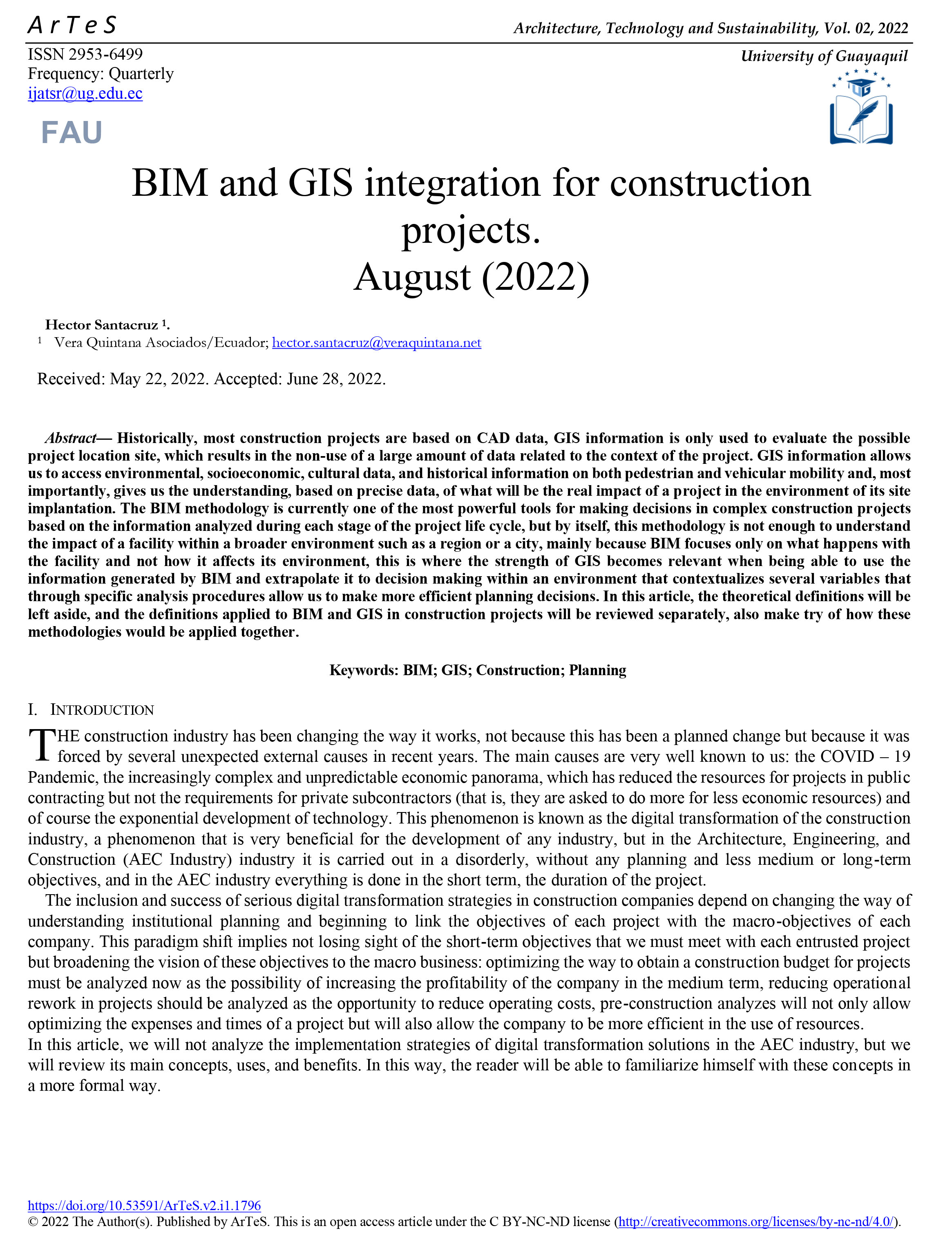Integración de BIM y GIS en proyectos de construcción. (Agosto 2022)
DOI:
https://doi.org/10.53591/ArTeS.v2.i1.1796Keywords:
Infraestructura, Ordenamiento territorial, perspectiva cultural y medioambiental, espacio público, recuperaciónAbstract
Historically, most construction projects are based on CAD data, GIS information is only used to evaluate the possible location of the project, which results in the non-use of a large amount of data related to the context of the project. project. GIS information allows us to access environmental, socioeconomic, cultural data, historical information on both pedestrian and vehicular mobility and most importantly, it gives us the understanding, based on precise data, of what the real impact of a project on the environment will be. of its implementation on the site. The BIM methodology is currently one of the most powerful tools for making decisions in complex construction projects based on the information analyzed during each stage of the project life cycle, but by itself, this methodology is not sufficient to understand the impact of a facility within a broader environment such as a region or a city, mainly because BIM focuses only on what happens with the facility and not how it affects its environment, this is where the strength of GIS becomes relevant when being able to use the information generated by BIM and extrapolate it to decision making within an environment that contextualizes several variables that, through specific analysis procedures, allow us to make more efficient planning decisions. In this article, the theoretical definitions will be left aside and the definitions applied to BIM and GIS in construction projects will be reviewed separately, also trying to see how these methodologies would be applied together.
References
S. Zhang, D. Hou, C. Wang, F. Pan y L. Yan, "Integración y gestión de BIM en SIG web 3D para proyectos de ingeniería hidráulica e hidroeléctrica", Automation in Construction, vol. 112, abril de 2020, DOI: 10.1016/j.autcon.2020.103114. Highway Capacity Manual, Transportation Research Board, National Research Council, Washington, DC, 2010.
Comité de Aceleración BIM, Manual BIM de Nueva Zelanda, vol. 5, 2019.
S. Mordue, "Implementación de un entorno de datos común. Beneficios, desafíos y consideraciones", Edimburgo, agosto de 2018.
S. a. Jones y HM Bernstein, El valor comercial de BIM para infraestructura: Abordar los desafíos de infraestructura de Estados Unidos con colaboración y tecnología. 2012.
ESRI, "¿Qué es SIG? | Tecnología de mapeo de sistemas de información geográfica", página web, 2022. https://www.esri.com/en-us/what-is-gis/overview (consultado el 1 de agosto de 2022).
A. Smith y J. Hania, "¿Qué es un SIG?", New Zealand Journal of Geography, núm. 110, págs. 5-10, 2000.
MF Goodchild, "Veinte años de progreso: GIScience en 2010 | Journal of Spatial Information Science", 2010. https://josis.org/index.php/josis/article/view/2 (consultado el 1 de agosto de 2022).
National Geographic Society, "GIS (Sistema de información geográfica) | National Geographic Society", 2022. https://education.nationalgeographic.org/resource/geographic-information-system-gis (consultado el 1 de agosto de 2022).
J. Zhu y P. Wu, "Integración de datos BIM/GIS desde la perspectiva del flujo de información", Automation in Construction, vol. 136, p. 104166, abril de 2022, DOI: 10.1016/j.autcon.2022.104166.
Autodesk Inc, "BIM_GIS Integration", Autodesk Inc., San Francisco, 2020. [En línea]. Disponible: https://www.autodesk.com/solutions/bim/explore-civil-infrastructure/bim-gis-ebook/thank-you
L. Zhao, Z. Liu y J. Mbachu, "Un método integrado BIM-GIS para la planificación del sistema de distribución de agua", ISPRS International Journal of Geo-Information, vol. 8, núm. 8, 2019, doi: 10.3390/ijgi8080331.
Y. Buhmann y Herbert-Wichmann-Verlag Karlsruhe, JoDLA Revista de Arquitectura Paisajista Digital 2-2017.

Downloads
Published
How to Cite
Issue
Section
License
Copyright (c) 2022 Artes: Architecture, Technology and Sustainability

This work is licensed under a Creative Commons Attribution-NonCommercial-NoDerivatives 4.0 International License.



